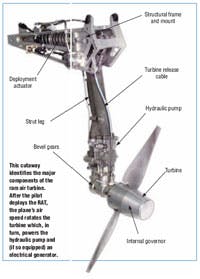RATs add safety to aircraft
Even if its engines fail, a modern aircraft can glide for very long distances if they start from a high enough altitude, but power for flight controls is needed for the crew to have an opportunity to land the plane safely. Ram air turbine (RAT) systems built by Hamilton Sundstrand in Rockford, Ill. can provide this emergency power in the unlikely event of a complete engine, hydraulic, or electrical failure. Hamilton Sundstrand supplies hydraulic RATs, electric RATs, and hybrid RATs (which combine an electric generator and pump). RATs are standard parts of the redundancy backup systems on modern-day business, regional, and large commercial jets, as well as military aircraft.
Ready when needed
Tom Gillis, director of engineering, Hamilton Sundstrand Electric Systems, explains that the RAT package consists of a turbine that is deployed into the external air stream by a spring-loaded actuator during an emergency situation. The turbine then powers a pump to pressurize the plane’s central hydraulic channel or a generator to power the essential electrical bus (or both in the case of a hybrid RAT). By judiciously selecting only essential hydraulic and/or electric functions, a crew can use the RAT output to maneuver a plane like a glider and land safely. In fact, there have been about 15 documented cases in which Hamilton Sundstrand RATs have been used and saved almost 2000 lives.
During normal flight, the turbine package is stowed away behind closed panels on the fuselage or (depending on the application) in the flap-trap fairing on an aircraft’s wing. In the case of a hydraulic RAT, if the aircraft’s hydraulic pressure drops, a release signal is sent automatically to the RAT uplock that holds it in its stowed position. (The crew also can deploy the RAT manually.) Once the uplock is released, a spring-loaded actuator deploys the RAT into the airstream, pushing the door open before it. Then, the air flowing past the aircraft drives the turbine blades, which power the pump.
Anatomy of a RAT
Hydraulic and hybrid RAT systems use an axial-piston, pressure-compensated pump. (Typically the pump is a special design for the particular application, although parts of the pump — say, the rotating group — may be existing designs.) According to Dave Chapman, principal engineer, Hamilton Sundstrand Electric Systems, RAT Systems, the pumps normally pressurize a 3000-psi (207-bar) hydraulic system, so they supply fluid at from 2400 to 2850 psi (165 to 197 bar), depending on the required flow. However, said Chapman, some Hamilton Sundstrand RAT systems provide hydraulic pressure up to 5000 psi, dependent on the architecture of the aircraft’s hydraulic system. Flow rates vary from 4 gpm (15 lpm) on smaller aircraft to 35 gpm (130 lpm) for large commercial applications.
Hydraulic pump controls
The pump has its own controls to maintain the system pressure at the demanded flow. Three common types of pump controls are used:
- A hard-cutoff pump maintains constant displacement until a pre-set pressure is reached, at which time the pump destrokes suddenly and sharply with any further pressure increase. In this fashion, constant pressure is maintained for flow demands up to rated flow.
- A soft-cutoff pump starts operation in a similar manner, but has a gradual or soft cutoff region where the pump destrokes gradually with pressure increase. In this region, a constant value of the product of displacement and pressure is maintained and a range of flow-pressure combinations is possible. This region is often referred to as a constant-horsepower state.
- Finally, some power-limiting-type pumps are more suitable for RAT applications because they approximate a constant-torque control. In this way, turbine stall is avoided because the load torque adjusts to match the available turbine torque.
Efficient turbine design
Turbine diameters of about 80 cm are common. (However, Hamilton Sundstrand’s RAT for the Airbus A380 is more than double that, at 162 cm.) When early model RATs were smaller, turbines were two- or fourbladed models, but now most deployable RATs have two blades that rotate at relatively high speed — resulting in greatly increased efficiency.
These turbine blades may be stored at coarse pitch, but as they start to rotate, flyweights and counterweights adjust the blade configurations to finer pitches that control the turbine’s rotational speed. RAT speed is governed in proportion to the turbine diameter, air speed, and emergency load requirement. For an 80-cm diameter turbine, the rotational speed range would be from 5500 to 7700 rpm for aircraft speeds between 125 to 375 knots.
Once the RAT is deployed and the turbine is governing, the pump, generator, or both put out power that is approximately 10% of what the aircraft requires for full hydraulic/ electric operation. This is enough to operate flight controls, linked hydraulics, and flight-critical instrumentation. The RAT power output will be reduced when the aircraft‘s speed drops — a factor with which pilots have to contend during emergency procedures.
Click here for additional information about ram air turbines.



